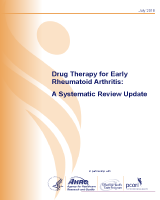| Disease activity | Responsea | No significant difference between SSZ + MTX and MTX alone4,
21–25 | Low for trials | Downgraded because open label design; high attrition; large CIs cross appreciable benefits or harms; and not enough events to meet optimal information size |
| Disease activity | Responsea | SSZ + MTX and MTX alone26 | Insufficient for obs evidence | Downgraded because high attrition; large CIs cross appreciable benefits or harms; and not enough events to meet optimal information size |
| Disease activity | Responsea | SSZ compared with MTX, with or without concomitant PNL27,
28 | Insufficient for both trials and obs evidence | Trials: Downgraded because high attrition; large baseline differences between groups; large CIs cross appreciable benefits or harms; and not enough events to meet optimal information size
Obs evidence: Downgraded because high attrition; large CIs cross appreciable benefits or harms; and not enough events to meet optimal information size |
| Disease activity | Responsea | TOF compared with MTX alone29 | Insufficient | Downgraded because high attrition; large CIs cross appreciable benefits or harms; and not enough events to meet optimal information size |
| Disease activity | Remission | SSZ compared with MTX, with concomitant PNL27 | Insufficient | Downgraded because high attrition; direction of effect varies; large CIs cross appreciable benefits or harms; and not enough events to meet optimal information size |
| Disease activity | Remission | TOF compared with MTX alone29 | Insufficient | Downgraded because high attrition; large CIs; and not enough events to meet optimal information size |
| Disease activity | Radiographic Changes | SSZ compared with MTX, with or without concomitant PNL27 | Insufficient | Downgraded because high attrition; large baseline differences between groups; large CIs cross appreciable benefits or harms; and not enough events to meet optimal information size |
| Disease activity | Radiographic Changes | SSZ + MTX and MTX alone4,
21,
22,
24,
25 | Insufficient | Downgraded because high attrition; large CIs cross appreciable benefits or harms; and not enough events to meet optimal information size |
| Disease activity | Radiographic Changes | TOF compared with MTX29 | Insufficient | Downgraded because high attrition; large CIs cross appreciable benefits or harms; and not enough events to meet optimal information size |
| Functional Capacity | N/A | No significant difference between SSZ + MTX and MTX alone4,
21–25 | Low | Downgraded because open label design; high attrition; and large CIs cross appreciable benefits or harms |
| Functional Capacity | N/A | No significant difference between PNL + MTX + SSZ + HCQ and monotherapy with MTX or SSZ22 | Low | Downgraded because open label design; high attrition; and large CIs cross appreciable benefits or harms |
| Functional Capacity | N/A | SSZ compared with MTX, with or without concomitant PNL27 | Insufficient for both trials and obs evidence | Trials: Downgraded because high attrition; not enough events to meet optimal information size; and large baseline differences between groups
Obs evidence: Downgraded because high risk of confounding by indication |
| Functional Capacity | N/A | TOF compared with MTX alone29 | Insufficient | Downgraded because large CIs cross appreciable benefits or harms, and not enough events to meet optimal information size |
| Harms | SAEs and D/C attributable to AEs | No significant differences between SSZ + MTX and MTX alone4,
21–25 | Low for trials | Downgraded because open label design; high attrition; and imprecision |
| Harms | D/C attributable to AEs | SSZ + MTX and MTX alone26 | Insufficient for obs evidence | Downgraded because of high risk of selection bias for treatment discontinuation; high risk of confounding by indication; and not enough events to meet optimal information size |
| Harms | SAEs and D/C attributable to AEs | TOF compared with MTX29 | Insufficient | Downgraded because high attrition; large CIs cross appreciable benefits or harms; and not enough events to meet optimal information size |
| Harms | D/C attributable to AEs | SSZ compared with MTX, with or without concomitant PNL27,
28 | Insufficient for both trials and obs evidence | Trials: Downgraded because high attrition; large CIs cross appreciable benefits or harms; and not enough events to meet optimal information size
Obs evidence: Downgraded because high risk of confounding by indication; large CIs cross appreciable benefits or harms; and not enough events to meet optimal information size |
